|
Diagnosing problems of plants can be challenging. There are some easily recognizable insects (with the aid of a hand lens or magnifying glass) and a few common diseases but diagnosing problems caused by improper care or environmental conditions can be challenging.
First, examine the plant thoroughly for insects. Use a hand lens or magnifying glass!
Then, look for signs of disease. Fungal diseases are most common for outdoor plants but there are also some bacterial diseases to be aware of. In some cases, a virus can be present that may only display symptoms under certain conditions.
Many problems are the result of unfavorable environmental conditions or improper care. These are grouped under environmental problems and can be difficult to recognize. You must examine the complete plant as well as the environment it is growing in. You should also judiciously dig around the plant to check the soil moisture level. Too dry or too wet soil can result in many problems.
It is common practice for the plant problem diagnostician to follow the steps outlined above, namely doing a close examination for insects and disease. If these are ruled out, then examine the soil, growing location, watering practices, and other cultural practices for clues. And, don’t forget, a plant may have more than just one problem. For example, the plant is covered with spider mites and also has been kept too dry.
Some problems may be quickly obvious but others may take considerable sleuthing and still the cause may be elusive. The following problems are some of the most common we see on many perennial and annual plants.
Click on a link below for more information and control strategies.
|
Insects
|
 Aphids
Aphids
|

Spider mites
|
 Japanese beetle
Japanese beetle |
Aphids are a large and diverse group of insects that vary in color, size and appearance. An aphid infestation may cause leaves that are curled, puckered, stunted or have pale yellow spots. Infected plants may also have distorted blooms. If aphids are present you may see a sooty, sticky, black substance on the leaves.
See:
Aphids - outdoors
|
Spider mites suck juices from plant leaves causing the leaf to look dull and unhealthy. Often you will see fine webbing on leaves, in the leaf axils or covering the entire plant. Spider mites are less than 1/60th of an inch and are difficult to see without a magnifying glass. However, when a leaf or branch is tapped over a sheet of white paper, the mites look like specks of dust or pepper that appear to move.
See:
Spider mites - outdoors
|
Japanese beetles are the adult stage of white grubs and are active for about 6 weeks in the summer. They are about 3/8 inches long and 1/4 inch wide and are a bright metallic green with copper brown wings. Damage to ornamental plants is primarily aesthetic and control is not essential for survival of the plant.
See:
Japanese beetle
|

Caterpillars - Surface feeders
|
 Iris borer
Iris borer
|
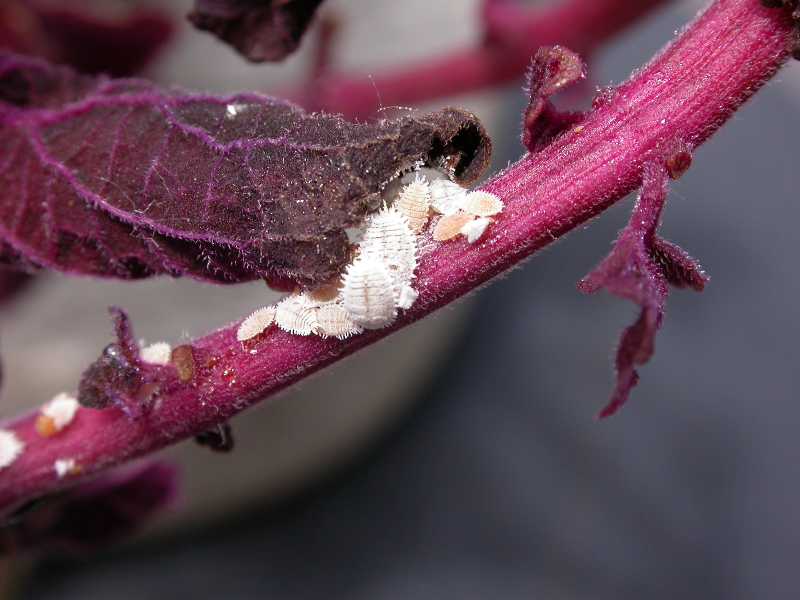 Mealybugs
Mealybugs
|
Caterpillars are larvae of moths and butterflies that feed on foliage and stems of many plants and cause holes in leaves, chewed leaf edges, or leaves that are rolled up or fastened with silk. Many do little damage so before considering a control method identify the insect. Remember, caterpillars are a valuable food source for birds and other wildlife.
See:
Caterpillars – Surface feeders
|
Iris borers cause more damage to iris plants than any other insect. Damage can be identified by dark water-soaked streaks in young leaves in May and June. Iris borer larvae tunnel down into the rhizome where they can open the rhizome to bacterial soft rot, which causes the leaves to yellow and fall over. The rhizome turn into a foul smelling mush. Removal and destruction of the prior year’s dead foliage by April 1 is key to preventing iris borer damage.
See:
Iris borer
|
Mealybugs can attack a wide variety of perennials and annuals. Although they can infest all plant parts, the infestation usually involves leaves, stems, branches and joints. They pierce leaves, stems and flowers and suck sap, excreting a sticky honeydew over leaves and stems that provides an excellent growth medium for a sooty-colored mold, giving the plant a dirty, sooty appearance. Ants are likely to be found feeding on the honeydew. Heavily infested plants will experience irregular or no growth, yellowed leaves, and significant leaf drop. Left untreated, plants can die.
See:
Mealybugs – outdoors
|
 Phlox bug
Phlox bug
|
 Tarnished and four-lined plant bug
Tarnished and four-lined plant bug
|
 Milkweed bug
Milkweed bug
|
The phlox bug is reddish orange and black. It feeds mainly on phlox and can cause serious damage. It is often difficult to see because it hides on the undersides of leaves. Phlox bug damage causes white or light green spots on leaves and buds that later show yellow stippling. Leaves turn brown, curl, dry out and drop. The plant may become stunted and die.
See:
Phlox bug
|
Tarnished and four-lined plant bugs feed on a wide variety of host plants. They are two of the most damaging insects on perennials. The adult four-lined bug has yellow or bright green forewings and four distinct black stripes. They feed on 250 plant species and cause small (1/16 inch) discolored areas on leaves. The tarnished bug is bronze or dark brown and 1/4 inch long with white marks or lines behind the head. These insects are a problem on a wide variety of ornamental flowers and can cause distorted foliage or bud drop.
See:
Tarnished and four-lined plant bugs
|
The milkweed bug is a large, orange-red and black insect that feeds on seedpods, leaves and stems of milkweed, often in high numbers. It is more of a nuisance than a threat to the plant. It does little damage to the plant and due to its short life cycle, is only present for a short time.
See:
Milkweed bugs
|

Flea beetle
|

Leafhopper and plant bugs
|

Stink bugs
|
Although flea beetles are a more common problem on vegetable crops, they can cause damage to perennials and annuals. Flea beetles can be black, brown, bronze or striped and are only 1/10th inch long. Due to their small size, they are easy to miss, but watch for a sudden burst of jumping black spots among leaves. Light infestations are characterized by tiny round holes in leaves. Heavier infestations may cause bleached or pitted areas, ragged holes or even total loss of leaves resulting in wilted or stunted plants.
See:
Flea beetle
|
Leafhoppers feed on a wide variety of herbaceous perennials and annuals. Adults are slender, 1/8 – 1/4 inch long and generally have a pointed or blunt head. They can be shades of yellow, green, brown or mottled. Damage can cause small white spots (stippling) to appear on the upper leaf surface, usually beginning near the leaf midrib. Stippled areas can unite into larger whitish blotches on mature leaves.
See:
Leafhoppers and planthoppers
|
Stink bugs can be found on many ornamental plants including columbine, snapdragon and sunflower. They are 1/4 – 1 inch long, shield-shaped, and almost as wide as long. As the name indicates, they may emit an offensive odor if disturbed. Damage can occur as yellow or white, papery blotches on leaves, misshapen or aborted buds. Large infestations of stink bugs can cause the plant to wilt, become stunted, misshapen or die.
See:
Stink bugs
|
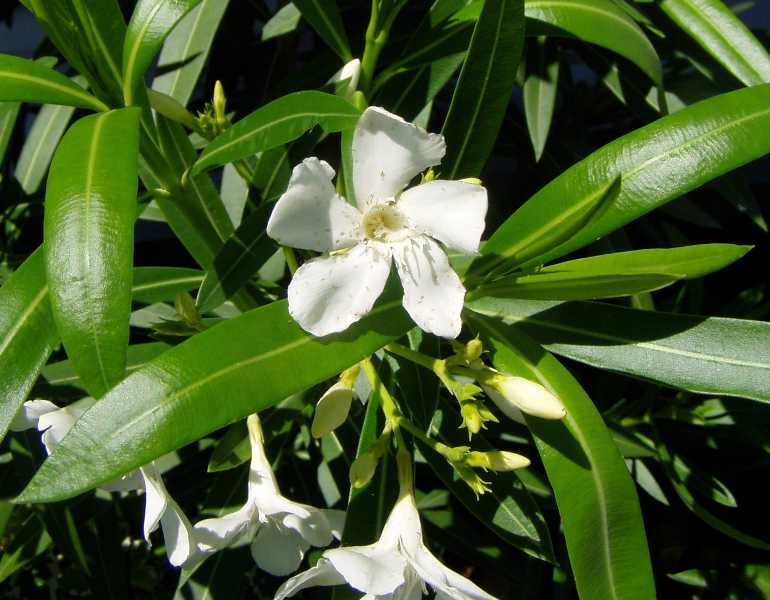
Thrips |
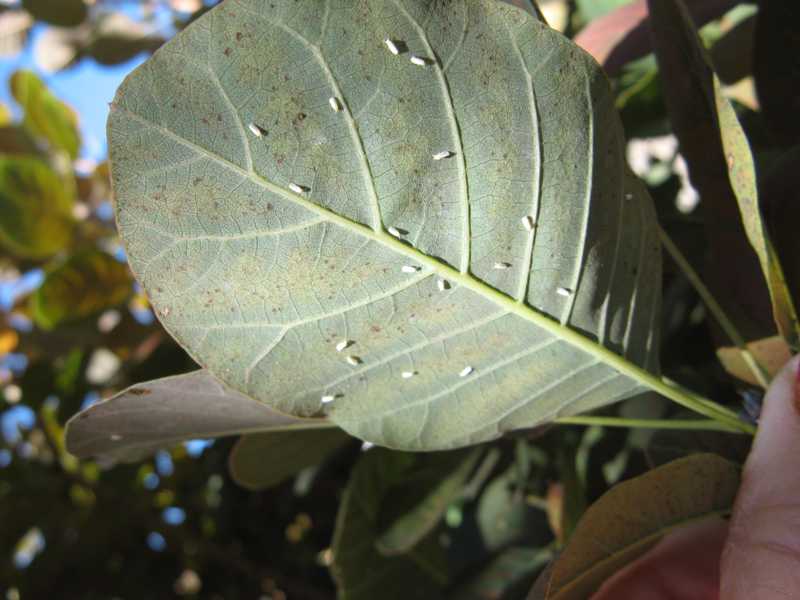
Whitefly |

Other mites |
Thrips are small, cigar-shaped, 1/16 to 3/16 inch long yellow to black insects. They attack flowers, leaves and buds of a variety of perennials and annuals. Thrips are most apparent on flowers with white, yellow or other light colored blooms. Thrips congregate by the hundreds and leave black, varnish like fecal deposits on the underside of leaves.
Thrips may cause foliage to appear dusty or silvery and dull. Blossoms can become streaked with brown and wither prematurely. Infected leaves are twisted, discolored and/or scarred.
See:
Thrips - outdoors
|
Whitefly can attack a wide variety of herbaceous plants including cannas, bearded iris, petunia, coleus, and lantana. Adults are 1/16 to 1/10 inch long and are easily identified as a white cloud that rises from plant foliage when disturbed. Infested leaves may be mottled, yellow and/or coated with a sticky substance called honeydew. A black sooty mold may sometimes grow on the honeydew. Symptoms include stunting, poor growth and defoliation.
See:
Whitefly - outdoors
|
Cyclamen and broad mites are microscopic pests that distort and deform growing tips of plants resulting in stunted tips, curled leaves and lack of flowering. They can be a serious pest of a wide range of plants including begonia, snapdragon, impatien, gerbera and ivy. Because of their small size (less than 0.02 mm in length), they generally are not detected until they cause significant damage. An eriophyid mite is also a pest of purple coneflower. The symptoms can mimic those of aster yellow.
See:
Cyclamen and broad mites
Eriophyid mites
|

Slugs |

Sowbugs |

Centipedes and Millipedes
|
Slugs are soil dwelling, soft bodied creatures closely related to snails and clams. Slugs prefer moist, shady areas of the garden and are common pests of hostas and groundcovers. They leave holes in leaves, stems and flowers and can sometimes shear off entire leaves. Slugs are nocturnal and can be found feeding on plants at night or in early morning.
See:
Slugs and snails
|
Sowbugs live in moist environments such as mulch, compost, flower pots and other damp areas. They range in size from 1/4 to 1/2 inch and are dark to slate gray. Usually, they do little harm to plants as their main source of food is decaying organic matter. In large numbers, however, they can cause feeding damage or cause wounds, which are subject to infection by fungi and bacteria.
See:
Sowbugs and pillbugs
|
Centipedes and millipedes prefer moist humid areas. They are more of a nuisance than a destructive garden pest. Millipedes feed on decaying plant material and are 1/2 to 6 inches long with 25+ pair of short legs (4 legs per body segment). Centipedes are predators feeding on insects and spiders. They are about 1 inch long with fewer than 25 pair of legs (2 legs per body segment) and are considered beneficial because they control insect populations.
See:
Centipedes and millipedes
|

Leaf-cutter bees
|

Leafminers |

Spittlebugs
|
Leaf-cutter bees are small native bees that are about 1/4 inch long. They are beneficial insects as they are important plant pollinators and cause only minor damage to ornamental plants. They cut half-moon shaped discs from leaves and then use the leaf tissue to form nest cells for the next generation.
See:
Leaf-cutter bees
|
Leafminers are larvae of black flies and some wasps and moths. They cause damage to a number of flowering plants. Eggs are laid on or in leaves. Larvae emerge and tunnel between the upper and lower surface leaving light green or brown serpentine tunnels or spots. Affected leaves may turn brown or yellow, look blistered, curled or collapse.
See:
Leafminers
|
Adult spittle bugs resemble leafhoppers. They are called spittle bugs because of the ‘spittle’ deposited on the plant by the nymphs. Although unsightly, it is not harmful to the plant. Injury is caused by the adults sucking plant juices which results in stunting, dwarfing and general loss of vitality.
See:
Spittlebugs
|
|
Diseases
|
 Powdery mildew
Powdery mildew
|
 Leaf spots
Leaf spots
|
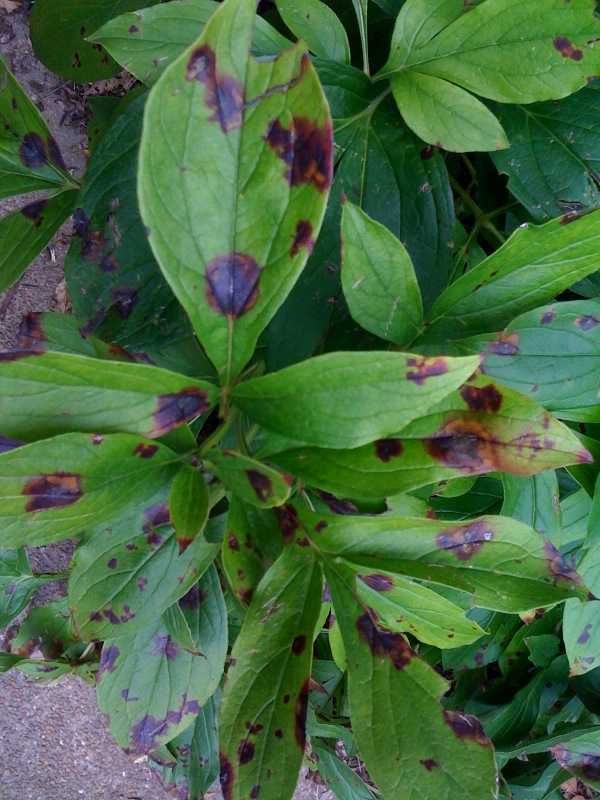 Peony problems
Peony problems
|
Powdery mildew is caused by a fungus. It appears as a light gray or whitish powder on the surface of leaves of many ornamental plants. It occurs following warm days and cool nights often being seen in the fall and spring. The disease is considered more unsightly than harmful. Death of the plant is rare.
See:
Powdery mildew - outdoors
|
Leaf spot is a common term applied to a variety of diseases affecting the foliage of ornamental plants. Leaf spots are usually caused by a fungus, but can be caused by bacteria in some cases. Spots are usually brown, but can be tan, black or reddish and can cause some defoliation of the plant.
See:
Alternaria Blight of Zinnia
Leaf Spots of English Ivy
Leaf spot of Rudbeckia
|
Botrytis blight is caused by a fungus and is a very common disease of peonies. It is prevalent during damp, rainy weather. Infected plants are covered with a dense, velvety gray mold. Young stems may rot at ground level.
Another fungal disease common to peonies is peony blotch. Initial symptoms will appear as small, circular, red or purplish spots on the upper surface of young leaves.
See:
Peony Blotch
Botrytis Blight of Peony
Peony Problems
|
 Botrytis blight
Botrytis blight
|
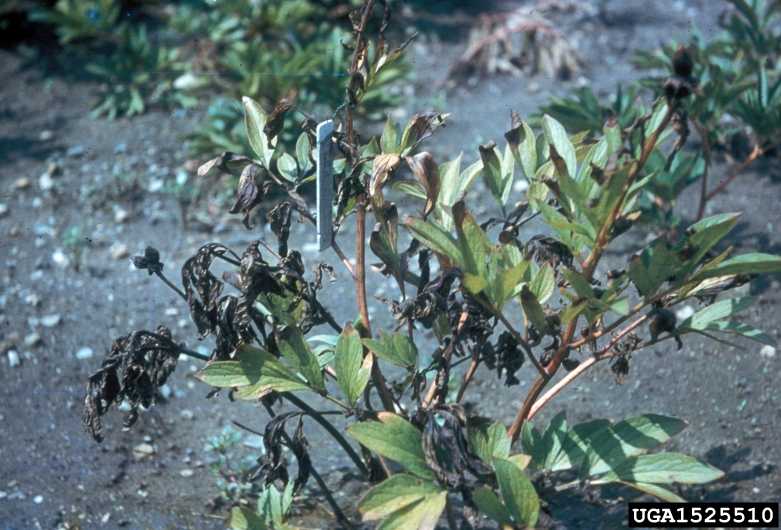 Blights and Wilts
Blights and Wilts
|
 Rusts
Rusts
|
Botrytis blight is a fungal disease affecting the buds, flowers, leaves and bulbs of a number of ornamental flowers. The disease causes buds and flowers to develop abnormally and turn brown. Flowers may have irregular flecks and brown spots and soft brown spots can appear on leaves, stems and flowers during cool, damp periods.
See:
Botrytis Blight
|
A blight is a plant infection caused by a pathogen. Blights cause sudden browning, yellowing and withering followed by death of plant tissue. Symptoms of wilt resemble those of blight and is caused when a fungus or bacteria attacks or clogs the plant’s vascular system. This affects the plant’s water conducting capabilities and causes permanent wilting often followed by death of all or part of the plant.
See:
Crown Rot of Perennials
Clematis Wilt
Vinca Stem Canker
Volutella Blight of Pachysandra
Damping off
|
Rusts are fungal diseases. They can cause yellowing, withering leaves and early leaf drop. Generally, rusts are host specific. For example, a hollyhock plant infected with hollyhock rust will not transmit the disease to an unrelated plant such as a hosta.
See:
Rust of Hollyhock
|

Viruses and Phytoplasmas
|

Nematodes |

Downy mildew
|
Viruses and phytoplasmas affect a variety of ornamentals and can be transmitted by insects or mites feeding on infected plants. They can also be transmitted mechanically by hands through touching or tools such as pruning shears. Symptoms are generally dwarfing, mottled foliage and/or yellowing or necrotic areas on leaves.
See:
Aster Yellow
|
Nematodes are microscopic roundworms. Most are soil dwelling, living on fungi and bacteria. While most aren’t harmful to the plant, a few are plant pathogens. They are grouped into several categories and those causing the most problems to ornamental plants are foliar nematodes which infest leaves, stems and buds. Symptoms of foliar nematode infestations include deformed leaves or yellow to dark brown spots between major leaf veins.
See:
Foliar Nematodes
Hosta Leaf Nematode
Root-Knot Nematodes
|
Downy mildew is a fungal disease of leaves and sometimes of pods and seed. The disease is more common on herbaceous plants and is favored by temperatures cooler than 65 degrees and by 100% relative humidity. Symptoms include the yellowing of leaves and the advanced development of white fungal growth on the undersides of older leaves. The three most important downy mildew diseases are those of impatiens, snapdragon and grape.
See:
Downy Mildew
Downy Mildew of Impatiens
|
|
Animals
|
 Rabbits
Rabbits
|
 Squirrels
Squirrels
|
 Deer
Deer
|
Rabbits can damage plants any time of the year and are especially troublesome in spring when young tender plants become widely available. Signs of rabbits include distinct round droppings, gnawing on stems of older woody plants, clean cut clipping of young stems and leaves, and tracks in the snow in winter.
See:
Rabbits
|
Squirrels can be a nuisance in the garden by uprooting new transplants and digging in flower pots. Other signs of squirrel damage are missing or partially eaten bulbs. In addition, they may eat succulent plant material.
See:
Squirrels
|
Deer are becoming a growing garden and landscape pest. They feed mostly at night and tear or jerk plants as they feed. Damage is characterized by torn leaves or stalks with ragged edges. While deer will eat most any plant when hungry, some control can be achieved by choosing plants that are less favored by deer.
See:
Deer
|

Voles and Mice
|
|
|
Voles and mice flourish in grassy or weedy areas. Voles create above ground pathways 1-2 inches wide often protected by overhanging vegetation. They prefer tender stems, foliage, flowers, seeds and many herbaceous plants. Voles can consume their own weight in plants every 24 hours.
See:
Voles and Mice
|
|
|
|
Environmental Conditions
|
|
 Drought and water stress
Drought and water stress
|
 Overwatering
Overwatering
|
 Transplanting shock Transplanting shock
|
Water requirements vary greatly among plants. Since symptoms may be similar to symptoms of overwatering or some pest and disease problems, it is important to identify the cause of the problem in order to take the proper corrective steps.
See:
Drought and Water Stress
|
Overwatering is one of the more common causes of plant problems. Damage caused by overwatering is frequently misdiagnosed as pest problems. Roots growing in waterlogged soil may die because they can’t function properly from a lack of oxygen in the soil. The dying roots decay and cannot supply the plant with water and nutrients. Heavy and poorly drained soils are more susceptible to overwatering issues.
See:
Overwatering
|
Transplant shock occurs if roots are damaged when transplanting or if soil, temperature or cultural conditions in the new site are vastly different from the old conditions. Plants may wilt, yellow or suffer overall decline.
See:
Failure to Establish
Improper and Damaging Gardening Practices
|
 Cold damage
Cold damage
|
 Scorch, sunburn and heat stress
Scorch, sunburn and heat stress
|
 Too little light
Too little light
|
Frost heaving is the most common cause of winter injury to ornamental plants. Widely fluctuating temperatures with repeated cycles of freezing and thawing causes water in the soil to expand and contract. This causes plants to be pushed out of the ground resulting in root damage. Elevated crowns and roots are exposed to cold temperatures and drying winds which may seriously damage, stunt or kill the plant.
See:
Frost Heaving
|
Scorch most often occurs following prolonged periods of dry, windy weather or bright sunshine. It is due to the inability of the roots to supply water to the foliage as rapidly as it is lost by transpiration from the leaves. Symptoms are browning of leaf margins and/or yellowing or darkening of areas between the main leaf veins.
See:
Scorch, Sunburn and Heat Stress
|
Light requirements vary for plants but they do need sufficient light in order to photosynthesize. Through photosynthesis plants produce energy for the plant. Plants suffering from insufficient light will lean toward the light source. If the plant is unable to photosynthesize due to lack of sunlight, the plant will become stunted and leaves may yellow and fall off.
|
 Poor flowering
Poor flowering
|
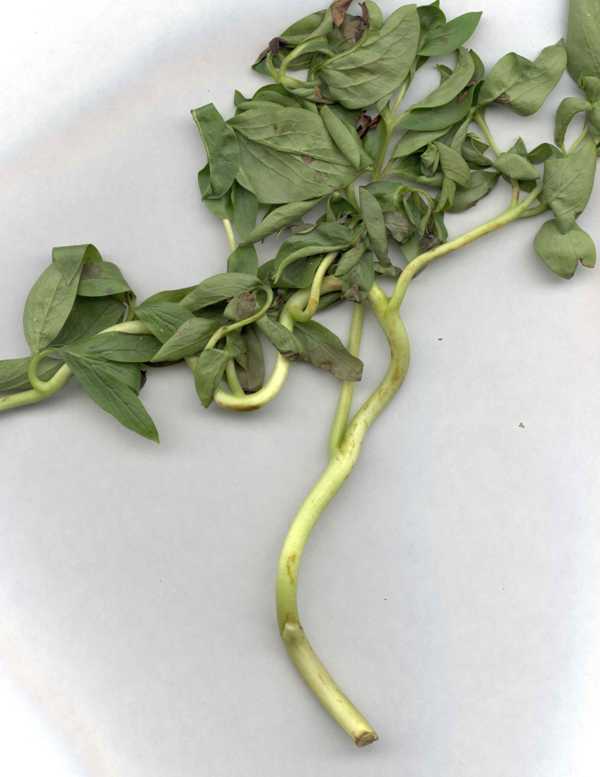 Herbicide damage
Herbicide damage
|
 Hail damage
Hail damage
|
Plants may not flower for a number of reasons. Some plants need to be established for two to three years before they will flower. Too much nitrogen or too little phosphorus will also cause poor flowering. Although light requirements vary by plant, inadequate light will reduce flowering. Blooming can also be affected by temperature.
|
Herbicide damage can be difficult to diagnose. It is advisable to first rule out insect or disease damage. General symptoms include one or more of the following. Curling or cupped leaves, stunted growth, discolored leaves or leaves with dead spots. The same herbicide may cause different symptoms on different plant species.
See:
Herbicide Damage to Plants
|
Hail can severely damage ornamental plants. The severity of the damage depends on the size of the hailstones and the time of the year that the hailstorm occurs. The later in the growing season that hail damage occurs the less time plants have to recover and store energy for the winter. Leaves, stems and flowers may be shredded, torn, punctured and knocked off.
See:
Hail Damage
|